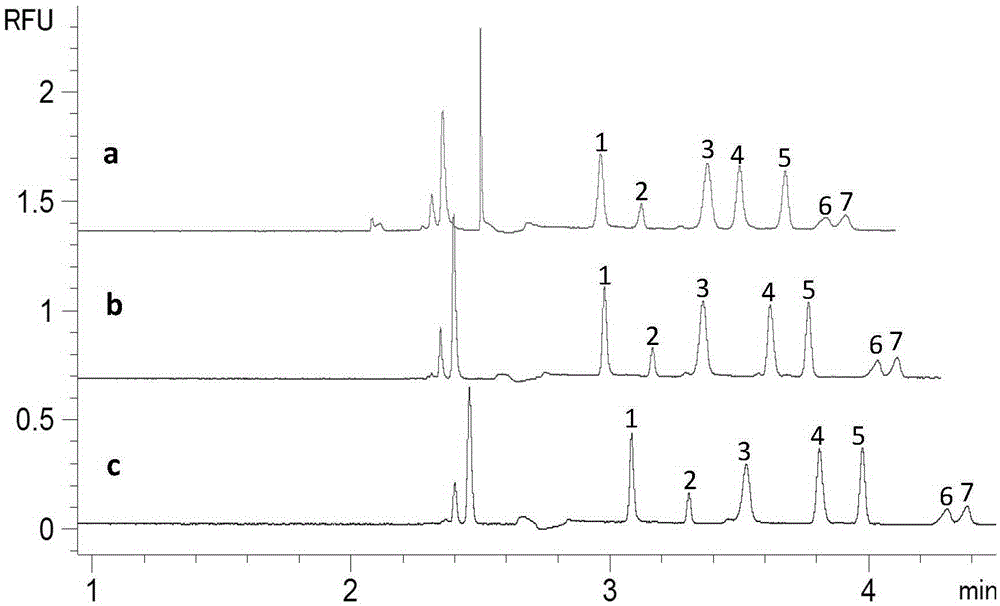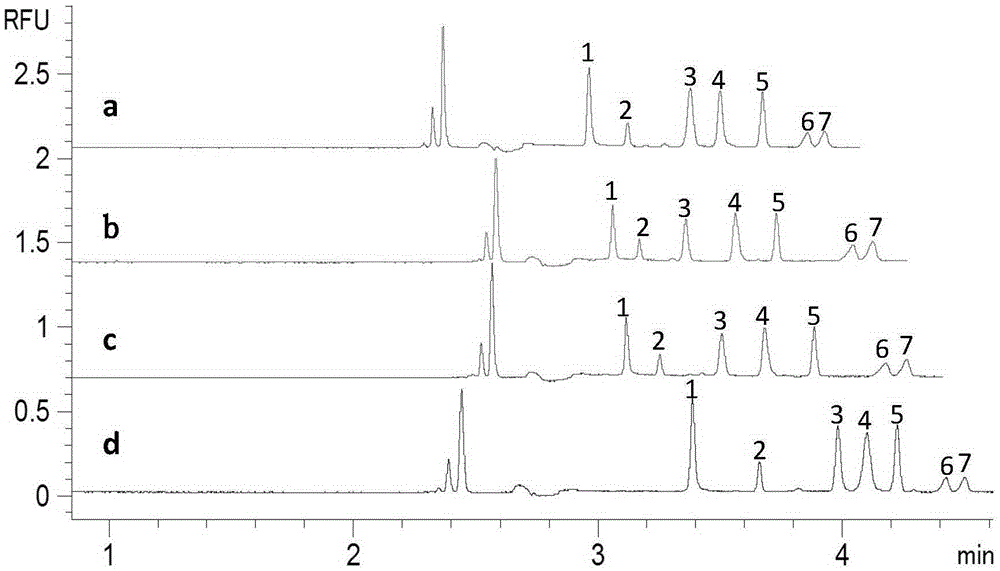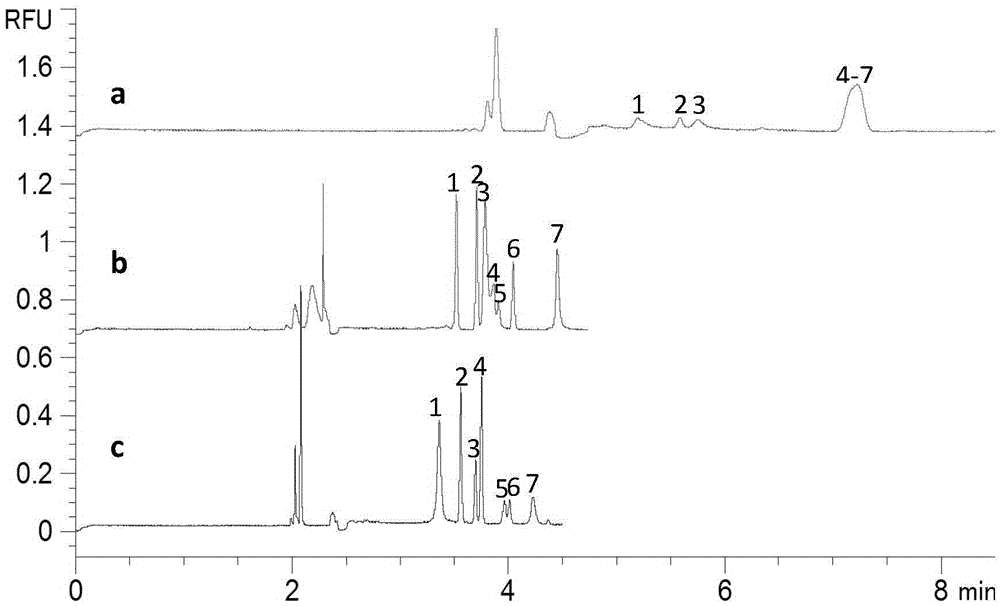A Fluorescent Detection Method for Flavonoids in Hawthorn
A technology of fluorescence detection and flavonoids, applied in fluorescence/phosphorescence, material excitation analysis, preparation of test samples, etc., can solve the problems of single instrument selection and use, high cost of HPLC, large consumption of mobile phase, etc., to achieve application The effect of wide range, lower production cost, price breakthrough
- Summary
- Abstract
- Description
- Claims
- Application Information
AI Technical Summary
Problems solved by technology
Method used
Image
Examples
Embodiment 1
[0047] Embodiment 1. The investigation of surfactant kind
[0048] 1.1 Take three clean 30ml jars, numbered 1, 2, and 3, and add 18mg of 3-sulfopropyl dodecyl dimethyl betaine to bottle No. 1, and add 18 mg of 3-sulfopropyl decathene to bottle No. Add 18 mg of 3-sulfopropylhexadecyl dimethyl betaine to tetraalkyl dimethyl betaine and No. 3 bottle, and then add 222 μL of n-butanol, 16.6 μL of ethyl acetate, and 750 μL of 20 mM borax to the three bottles Aqueous solution, 2.037ml of water, ultrasonic (100W, 40kHz) at 30°C for 20 minutes to prepare a microemulsion buffer solution.
[0049] 1.2 Take three 0.22μm organic membrane filters, corresponding to No. 1-3 syringes numbered 1, 2, and 3, and use the filter to filter the buffer solution in the syringe according to the corresponding number, one buffer solution corresponds to two A sample vial was loaded into a total of 6 sample vials. The buffer in the sample bottle is flushed into the capillary column as the buffer for capil...
Embodiment 2
[0054] Embodiment 2. Investigation of surfactant concentration
[0055] 2.1 Take 4 clean 30ml jars, numbered 1, 2, 3, 4, add 9mg of 3-sulfopropyl dodecyl dimethyl betaine and 2.046mL water into No. 1 bottle, add 18mg3 -Sulphopropyldodecyldimethylbetaine and 2.037mL of water, add 27mg of 3-sulfopropyldodecyldimethylbetaine and 2.028mL of water to bottle No. 3, add 36mg of 3-sulfopropyl betaine to bottle No. 4 Dodecyl dimethyl betaine and 2.019mL of water, and then add 222μL of n-butanol, 16.6μL of ethyl acetate, and 750μL of 20mM borax aqueous solution to four bottles, and ultrasonic (100W, 40kHz) at 30°C for 20 minutes. into a microemulsion buffer solution.
[0056] 2.2 Take four 0.22μm organic membrane filters, corresponding to No. 1-4 syringe numbers 1, 2, 3, 4, and use the filter to filter the buffer in the syringe according to the corresponding number, a buffer Corresponding to two sampling vials, a total of 8 sampling vials were loaded. The buffer in the sample bottle ...
Embodiment 3
[0064] Embodiment 3. Co-surfactant type investigation
[0065]3.1 Take three clean 30ml wide-mouth bottles, numbered 1, 2, and 3. Add 229 μL isopropanol to No. 1 bottle, add 221 μL pentanol to No. 2 bottle, and add 190 μL cyclohexanol to No. 3 bottle, respectively. Add 18 mg of 3-sulfopropyldodecyl dimethyl betaine, 16.6 μL of ethyl acetate, 750 μL of 20 mM borax aqueous solution, and 2.037 ml of water into three bottles, and ultrasonically (100W, 40kHz) at 30°C for 20 minutes to form a microemulsion buffer solution.
[0066] 3.2 Take three 0.22μm organic membrane filters, corresponding to No. 1-3 syringes numbered 1, 2, and 3, and use the filter to filter the buffer in the syringe according to the corresponding numbers. One buffer corresponds to two A sample vial was loaded into a total of 6 sample vials. The buffer in the sample bottle is flushed into the capillary column as the buffer for capillary electrophoresis, and the reference solution is injected.
[0067] Capilla...
PUM
 Login to View More
Login to View More Abstract
Description
Claims
Application Information
 Login to View More
Login to View More - R&D
- Intellectual Property
- Life Sciences
- Materials
- Tech Scout
- Unparalleled Data Quality
- Higher Quality Content
- 60% Fewer Hallucinations
Browse by: Latest US Patents, China's latest patents, Technical Efficacy Thesaurus, Application Domain, Technology Topic, Popular Technical Reports.
© 2025 PatSnap. All rights reserved.Legal|Privacy policy|Modern Slavery Act Transparency Statement|Sitemap|About US| Contact US: help@patsnap.com



